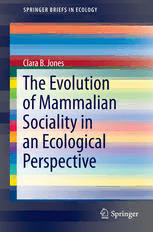
The Evolution of Mammalian Sociality in an Ecological Perspective PDF
Preview The Evolution of Mammalian Sociality in an Ecological Perspective
SpringerBriefs in Ecology Forfurthervolumes: http://www.springer.com/series/10157 Clara B. Jones The Evolution of Mammalian Sociality in an Ecological Perspective 2123 ClaraB.Jones MammalsandPhenogroups(MaPs) Asheville NorthCarolina USA ISSN2192-4759 ISSN2192-4767(electronic) ISBN978-3-319-03930-5 ISBN978-3-319-03931-2(eBook) DOI10.1007/978-3-319-03931-2 SpringerChamHeidelbergNewYorkDordrechtLondon LibraryofCongressControlNumber:2013958320 © ClaraB.Jones2014 Thisworkissubjecttocopyright.AllrightsarereservedbythePublisher, whetherthewholeorpart of the material is concerned, specifically the rights of translation, reprinting, reuse of illustrations, recitation,broadcasting,reproductiononmicrofilmsorinanyotherphysicalway,andtransmissionor informationstorageandretrieval,electronicadaptation,computersoftware,orbysimilarordissimilar methodologynowknownorhereafterdeveloped.Exemptedfromthislegalreservationarebriefexcerpts in connection with reviews or scholarly analysis or material supplied specifically for the purpose of being entered and executed on a computer system, for exclusive use by the purchaser of the work. DuplicationofthispublicationorpartsthereofispermittedonlyundertheprovisionsoftheCopyright LawofthePublisher’slocation,initscurrentversion,andpermissionforusemustalwaysbeobtained from Springer. Permissions for use may be obtained through RightsLink at the Copyright Clearance Center.ViolationsareliabletoprosecutionundertherespectiveCopyrightLaw. Theuseofgeneraldescriptivenames,registerednames,trademarks,servicemarks,etc.inthispublication doesnotimply,evenintheabsenceofaspecificstatement,thatsuchnamesareexemptfromtherelevant protectivelawsandregulationsandthereforefreeforgeneraluse. While the advice and information in this book are believed to be true and accurate at the date of publication,neithertheauthorsnortheeditorsnorthepublishercanacceptanylegalresponsibilityfor anyerrorsoromissionsthatmaybemade.Thepublishermakesnowarranty,expressorimplied,with respecttothematerialcontainedherein. Printedonacid-freepaper SpringerispartofSpringerScience+BusinessMedia(www.springer.com) Preface ThisSpringerBriefconcernsthecondition-dependenteffectsofintraspecificcompe- titiononamammal’sreproductiverate,aswellasactionsavailabletoanindividual (hereafter “type” [genotype and phenotype]) in the face of competition. Group- formation,group-maintenance,andsocialitymaybefavoredbyselectionwhengenes ofsocialtypesincreaserelativetonon-socialtypes,beyondsomethresholdlevelin a population. When “social” and “sociality” are defined as responses facilitating thereproductionofoneormoreconspecific, socialityisnotaconspicuousfeature of Class, Mammalia. Facilitation appears in response to density-dependent condi- tions characterized by “thermal stress” (stimuli negatively impacting reproductive rate) when niche spaces (“thermal zones”) of (conspecific) types (genotypes and phenotypes: individuals, organisms) overlap relative to variations in resource dis- persion(distribution, abundance, and/orqualityoffood, mates, and/orspace).The previousconditionsconstituteintermediateorhighlevelsofcompetitionforlimiting resources, resources influencing the reproductive rates of types. Group-formation and group-maintenance are necessary, but not sufficient, precursors to the evolu- tion of sociality, and recent treatments show that coexistence of different types is best studied using a “trait-based approach”. In theory, a type can be decomposed intoasetofexpressibletraitswithvaryingvaluesdependentuponcondition.Social traitsexpressedbytypesinclude“alloparenting”,cooperation,reciprocity,andaltru- ism, unambiguous and measurable features of phenotypes permitting independent quantitativeanalyseswithinandbetweenpopulationsandspecies. MammalswerepreadaptedforsolitarylivingduringtheTriassicwhenmammal- likereptilesescapedreptiliancompetitorsbyadoptingnocturnalhabits.Consistent withtheancestralpatternsofextantmammalsandreptiles,theformerare,primarily, nocturnal and solitary, the latter, primarily, diurnal. In general, extant adult male mammalsareintolerantofothermalesandoftheyoung,whileadultfemales,unless signalingsexualreceptivity,areintolerantofconspecificsotherthantheiroffspring andofmales.Thewhole-organismphenotypeofonemammalisexposedtoabiotic (soil, climate) and biotic (plants, predators) environments that may or may not be correlatedacrossspaceandtime.Ultimately,selectionactsongenetically-correlated phenotypictraitsand,fromagenotype’sperspective,copiesofallelesandtheiras- sociatedtraitsmaybecarriedorexpressedthroughoutapopulationand,sometimes, v vi Preface aregion(“metapopulation”).Foragivengenotype,phenotypeswillvaryspatiotem- porally within and between individuals bearing a trait or traits. Mammals found in aggregations (temporary assemblages of one or more than one species), or spa- tiotemporally recurrent groups, may or may not occur in proximity to individuals bearing the same genotype because dispersing types may travel near (“viscosity”) or far from their natal groups. A type will be designed to do the best it can do to maximizeitsrelativefitness(growthrate)inapopulation,eventhoughnichespaces ofsimilartypeswilloverlap,yieldingcompetitionforlimitingresources(e.g.,food, mates,space).Thus,interestsoftypesmaynotcoincide,particularlykinwhoseniche spacesareboundtooverlap,andresponsesinfluencingreproductiveratesofsimilar or different types may have beneficial or deleterious effects on per capita rates of populationgrowth. Expandingothertreatments,intensitiesofwithin-andamong-speciescompetition in local (“patch”) and regional (population, metapopulation) regimes are expected to determine benefits and costs to each mammal’s current and future reproduction viacondition-dependentinteractionsbetweengenotypeandenvironment(“reaction norms”),includinginteractionswithothermembersofanaggregationorintegrated group. Throughout the present review, mammals are assumed to reside in a com- petitivecontext,withintheindividualmammal’sgroup,betweengroups,andwithin populations,communitiesandecosystems,andinteractionsbetweenoramongcon- specificsmaybecategorizedasfacilitation,tolerance,orinhibition.Thetopicofthe presentsynthesisismammaliansocialevolution,and,throughoutthetext,“facilita- tion” is employed generically to mean facilitation of a type’s relative reproductive interestsviathefacilitationofanothertype’sreproductiveinterests,usuallyanother groupmemberandoftenarelative. Evolutionary transitions to sociality within and between mammalian taxa are central to a scientific understanding of sociality as a phenomenon, since the Class constitutes the most ecologically dominant terrestrial vertebrate fauna, including grades of population structure from “solitary” (“sexually-segregated”) to eusocial (overlappinggenerations,cooperativebreeding,reproductivedivisionoflabor).Ster- ilecasteshave,apparently,notevolvedamongmammals;thus,inthepresentbrief, cooperativelybreedingandeusocialmoleratsareclassifiedas“primitivelyeusocial”. In addition, this monograph discusses factors associated with group-formation, group-maintenance, group population structure, and, other, events and processes (e.g., physiology, behavior). Within- and between-lineages, features of prehistoric and extant social mammals, patterns and linkages are discussed as components of a possible social “tool-kit”, and “top-down” (predators to nutrients), as well as, “bottom-up”(nutrientstopredators),effectsareassessed.Thepresentsynthesisalso emphasizesoutcomesofHebbian(synaptic)“decisions”onMalthusianparameters (growth rates of populations) and their consequences for (shifting) mean fitnesses of populations. Ecology and evolution (EcoEvo) are connected via the organism’s “normsofreaction”(genotype×environmentinteractions;life-historytradeoffsof reproduction,survival,andgrowth)exposedtoselection,withthesuccessofgeno- typesinfluencedbyintensitiesofselectionaswellasneutral(e.g., mutationrates) and stochastic effects. At every turn, life history trajectories are assumed to arise Preface vii from “decisions” made by types responding to competition for limiting resources constrainedbyHamilton’srule(inclusivefitnessoperations). Thisandpreviousprojectswouldnothavebeenpossiblewithoutefforts,construc- tivecriticisms,andotherinputsfrommanyindividuals.IthankJanetSlobodienand herstaffforfacilitatingthecurrentproject.Mygraphicsassistants,MonicaE.Mc- Garrity,LizWilliams,aswellasCharlaSchlueter,deservementionfortheirtechnical talentsandpatience.IamverygratefultoKennethD.Angielczyk,LeeDrickamer, TedFleming,StevenA.Frank,TarmoKetola,PhyllisC.Lee,JesseMarczyk,Daniel J. Mennill, Peter Nonacs, Craig Packer, Michael Platt, Randy Thornhill, Robert L. Trivers, Gene E. Robinson, two anonymous reviewers and, especially, Andrew Bourke, for responding to my questions or commenting on one or more sections of this brief. My children, Dalton Anthony, Julie Karin, and Miguel Luke Jones providedinsight, goodhumor, andsupport.Thisbriefisdedicatedtomyteachers, mentors,andcolleagues. Contents 1 Introduction:Definitions,Background............................ 1 1.1 Different“Routes”toSociality ............................... 2 References..................................................... 6 2 CompetitionforLimitingResources,Hamilton’sRule, andChesson’sR* .............................................. 9 2.1 Westetal.(2002)PlacesHamilton’sRuleintheContext ofIntraspecificCompetition.................................. 10 2.2 GeneralizingChesson’sR*andLinkingittoHamilton’sRule...... 13 References..................................................... 17 3 Flexible and DerivedVarieties of Mammalian Social Organization: PromiscuityinAggregationsMayHaveServedasaRecent“Toolkit” Giving Rise to “Sexual Segregation,” Polygynous Social Structures, Monogamy,Polyandry,andLeks ................................ 19 3.1 TheEvolutionofThermalNichesandtheEvolution ofMammalianSociality ..................................... 25 3.2 AbioticandBiotic“Drivers”ofBodySizesandHome-Range SizesinMammals .......................................... 26 3.3 WhatRolesDoMammalianMalesPlayinDeterminingPopulation Structure? Interactions Between Intrasexual Selection, Sexual Dimorphism in Home Range Sizes, and the Potential for Male MonopolizationofFemales .................................. 28 3.4 “Promiscuous”Associations with Overlapping Home Ranges WithoutMaleMonopolization:AMammalian“Toolkit” .......... 30 3.5 “Solitary”MammalsandSexualSegregationGradetoPolygyny ... 32 References..................................................... 33 4 Multimale-Multifemale Groups and “Nested” Architectures: CollaborationAmongMammalianMales ......................... 37 4.1 IncipientDivision-of-LaborinMultimale-Multifemale GroupsofMammals ........................................ 38 4.2 “Nested” (“Hierarchical,” “Modular”) Social Organization and Management of Competition as Well as Competition byQueuing................................................ 39 ix x Contents 4.3 QueuingMayMinimizel*LevelsforSuperiorTypes............. 42 References..................................................... 43 5 Higher“Grades”ofSocialityinClassMammalia: PrimitiveEusociality ........................................... 47 5.1 PrimitivelyEusocial“Cooperative”Breeders.................... 48 5.2 PrimitivelyEusocialMoleRats ............................... 49 5.3 TowardaSocial“Toolkit”.................................... 50 5.4 MammalianSocialityandSocialInsects:Convergent PatternsEmerge............................................ 52 References..................................................... 53 6 EcologicalModelsasWorkingParadigmsfor“Unpacking”Positive andNegativeInteractionsAmongSocialMammals ................ 55 6.1 TheBehavioralEcologyofGroupFormationandStable MaintenanceofGroups...................................... 56 6.2 PredationMayFacilitateGroupFormation,aNecessary PrecursortoSocialEvolution................................. 57 6.3 InterspecificCompetitionMayFacilitateMammalianGroup Formation,aNecessaryPrecursortoSocialEvolution ............ 58 6.4 HowRobustarePredationandInterspecificCompetition as Conditions for the Evolution of Group Maintenance, Possibly LeadingtoSocialEvolutioninMammals....................... 59 References..................................................... 61 7 MechanismsUnderlyingtheBehavioralEcologyofGroupFormation 65 7.1 Behavioral Ecology, a Paradigm for the Evolution of Group Structure:ExtrinsicFactorsShape“Decisions”MadebyTypes .... 66 7.2 Types Influence and Are Influenced by Abiotic and Biotic Regimes:PositiveandNegativeEffectsAmongSpecies........... 68 7.3 A Case Study of Community Assembly: Superior andInferiorCompetitors..................................... 73 References..................................................... 76 8 TheEvolutionofMammalianSocialitybySexualSelection ......... 81 8.1 TheEnergeticsofSexualAllocation ........................... 82 8.2 “Sexual Conflict” Between Mammalian Males and Group-Living Females:EcologyInteractswithTraits ......................... 85 8.3 TheEco-EthologyofMaletoFemaleAggression ................ 85 8.4 ASimpleModelofMaletoFemaleAggressioninMammals ...... 88 8.5 Managing Conflict Where More than One Males Coreside withReproductiveFemales .................................. 90 8.6 AFinalNoteonFemales:PotentialsandConstraints ............. 91 References..................................................... 93 Contents xi 9 ProximateCausation:FunctionalTraitsandtheUbiquityofSignaler toReceiverInteractions:FromBiochemicaltoWholeOrganismLevels ofMammalianSocialOrganization .............................. 97 9.1 AnIntegrationofSocialNeuroscienceandEcologyIsontheHorizon 99 9.2 MammalianSociogenetics:WhatGenesDoWhat,andHow?...... 99 9.3 ThePromiseofMammalianSociogenomicsHasYettoBeRealized 101 References..................................................... 101 10 Synopsis ...................................................... 105 10.1 Synopsis .................................................. 105 10.2 Coda ..................................................... 106 References..................................................... 109 Index ............................................................ 111
